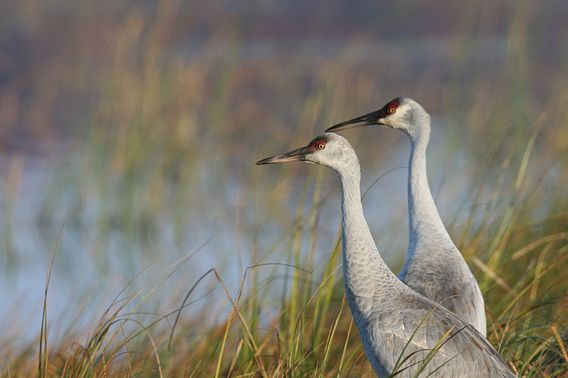The return of the sandhill crane to Wisconsin is a conservation success, but now the state needs to manage the population and the crop damage the birds can cause. (Wisconsin Department of Natural Resources)
Rick Gehrke operates a farm outside of Omro where he mainly grows corn, soybeans and alfalfa. On Wednesday, he laid out how catastrophic damage from sandhill cranes can be to a farmer if the birds force farmers to re-plant their crops.
Corn is most vulnerable to sandhill crane damage in the month after the seeds are planted before the stalks grow taller than eight inches. If the birds destroy a field after it’s planted, Gehrke said — accounting for time, labor, gas and added costs in the fall caused by planting late — the cost to the farmer can go from about $150 per acre to more than $300. In an agricultural world in which farmers’ profit margins are getting smaller, that increase can be devastating.
Gehrke, also a board member of the Wisconsin Corn Growers Association, spoke at a meeting of a Legislative Study Committee looking at how the state can help farmers address the estimated $900,000 in damage the birds cause to corn crops every year, as well as additional damage to farmers who grow potatoes, cranberries and other vegetables.
Gehrke said that the best option available to farmers is Avipel, a chemical compound put on the seed before it’s planted that makes it unappetizing to the birds.
“It has been somewhat effective, or probably the most effective method that we do have on the farm as of right now,” he said.
But, he said, it’s not a perfect solution. The chemical costs about $15 an acre, so it’s cheaper than replanting, but can still add up.
Plus, if a farmer only treats one field, the birds will often just move to a nearby untreated field. And for the treatment to even work, the birds have to dig up and eat five or six seeds to realize they don’t like the taste. If a flock of 200 cranes lands on a field and all of them need to eat five seeds before realizing the corn can’t be eaten, that still causes quite a lot of damage.
Sandhill cranes are a conservation success story in Wisconsin. The number of breeding pairs once dropped to 15; now an estimated 100,000 live across the upper Midwest. But that success has come with crop damage as much of the agricultural land in central Wisconsin covers the bird’s historical range, traditionally wetlands and prairies.
A farmer in Wisconsin who has crops damaged by cranes can apply for a depredation permit from the U.S. Department of Agriculture. That permit allows the farmer to shoot and kill a number of birds, but the farmer must first exhaust other abatement methods, including treating seeds with Avipel.
Hunting sandhill cranes has been a political issue in Wisconsin for many years. Several bills have been introduced in the Legislature to create a hunting season for the birds, which hunting advocates often call “ribeyes in the sky.”
Wisconsin’s wildlife damage abatement program, which pays farmers for crop damage caused by animals such as deer and geese, includes a provision that states sandhill crane damage can only be claimed under the program if there is a hunting season for the birds.
Conservation groups, including the Baraboo-based International Crane Foundation, oppose a hunt. Opponents contend that a hunt in which the state Department of Natural Resources set a quota for a few thousand birds wouldn’t do anything to solve the crop damage problem — and could in fact make it worse by opening up territory controlled by one pair of mates to a much larger flock.
The wildlife damage abatement program is largely funded by a $2 fee added on to the cost of most hunting licenses, Hunters argue that if they’re going to be paying for the cost of damages caused by cranes, they should be able to hunt them.
“I think something that’s very important is that the damage abatement money is coming from hunting licenses, and unless there’s an alternate source, they have basically told us that sandhill cranes would probably disseminate that fund within a few years,” Rep. Paul Tittl (R-Manitowoc), the committee’s chair, said at Wednesday’s study committee meeting. “If we were going to do that, I think this capital might be flooded with a lot of orange … hunters will not think very kindly of taking money from their license fee and putting it towards something that they can’t harvest.”
The committee includes legislators and groups representing the interests of conservationists, hunters and farmers. Wednesday the legislators questioned the best way to construct a program that could help farmers harmed by crane damage. Sen. Mark Spreitzer (D-Beloit) asked Gehrke if he thought farmers would be better off if the state subsidized the cost of treating seed with Avipel or just reimbursing farmers for damage after it happens.
Gehrke said that farmers would likely be happy to avoid the paperwork associated with reimbursement.
“I would say, I would think most farmers would support and be happy with [help in to covering] the cost of the Avipel,” he said. “Anytime you have crop damage, it’s usually more of a hassle to go through all the paperwork and all that kind of thing, to where most farmers just say, the heck with it, we’ll live with it — [that] type of thing. So if there’s any kind of subsidy that we could do for the cost of Avipel, I think they would be greatly appreciated.”
GET THE MORNING HEADLINES DELIVERED TO YOUR INBOX

